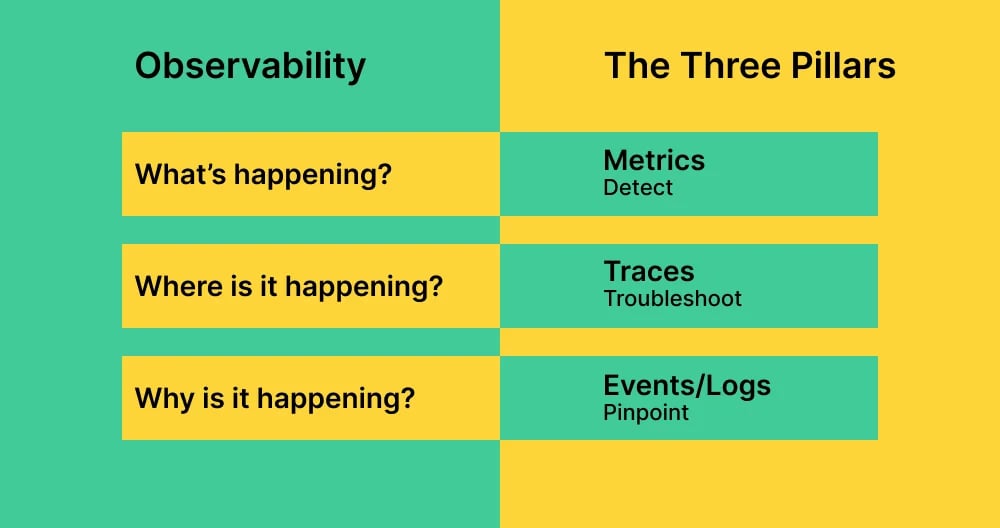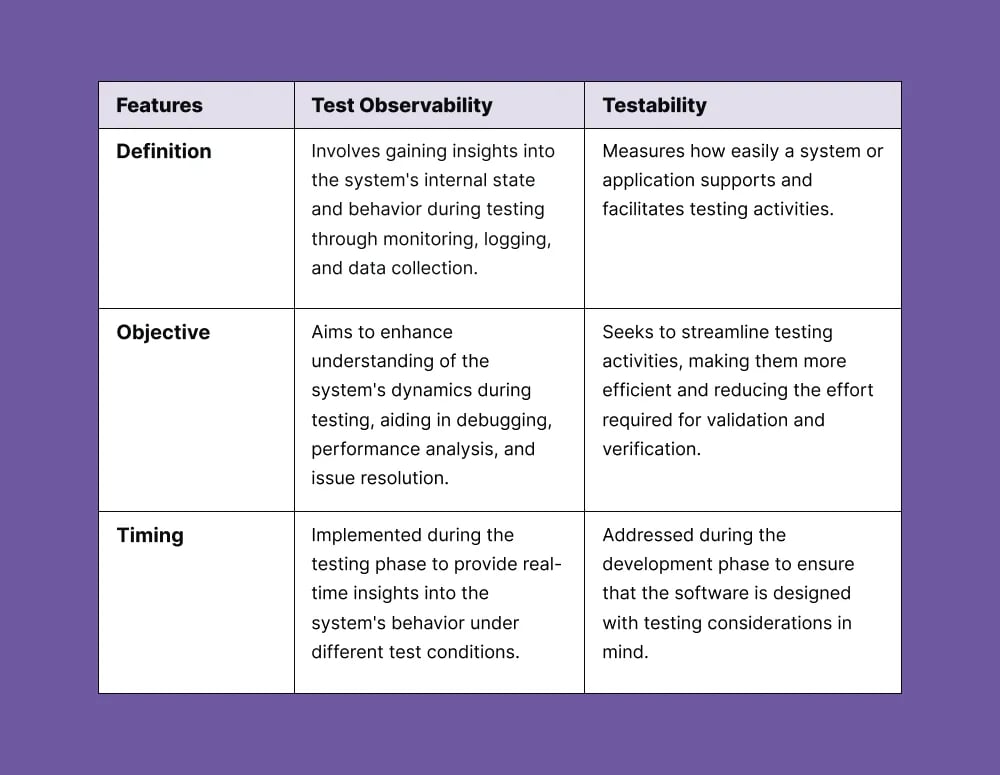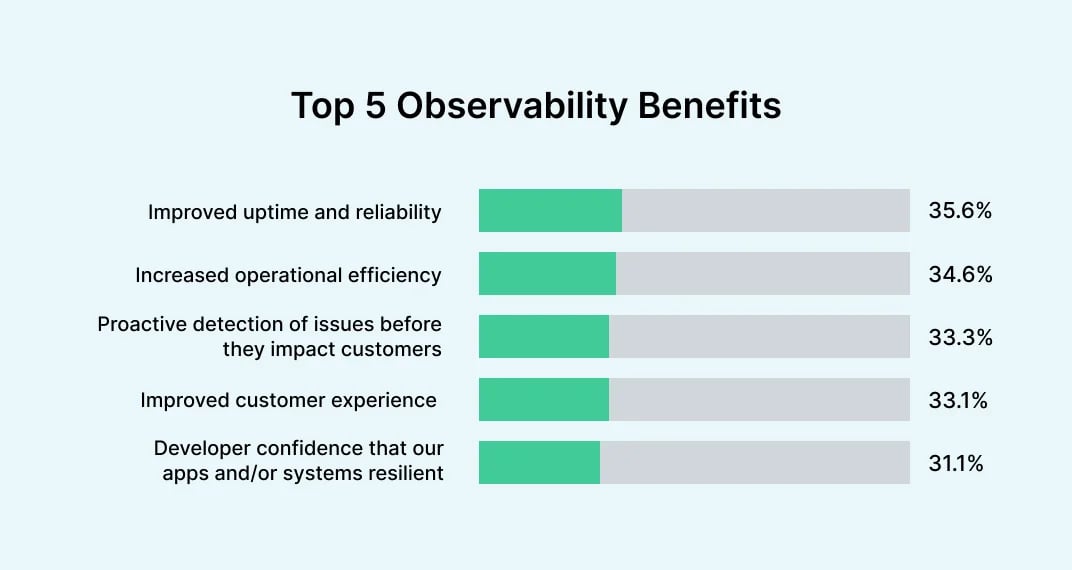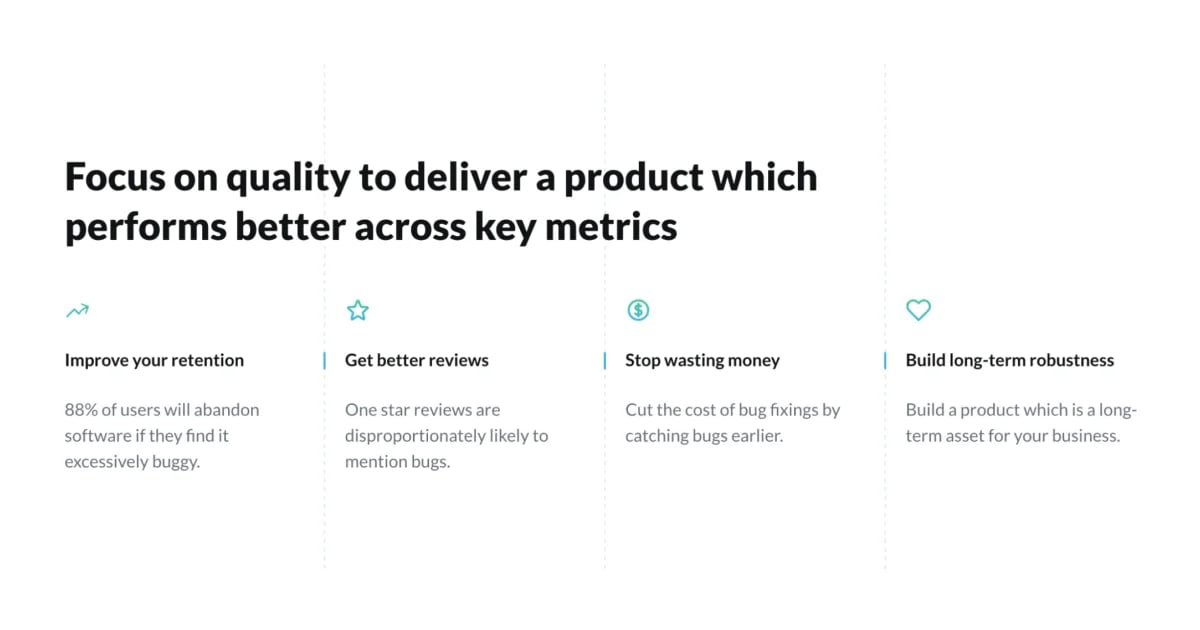What's "observability" in software testing? Here's what you need to know
Although commonly associated with reliability engineering, observability offers testers valuable insights into complex systems, simplifying the process of understanding and navigating them. Consequently, testers and their teams are better equipped than ever to enhance the quality of a system, including its security, reliability, and performance.
What is observability in software testing?
Test observability is about gaining detailed insights into how software tests are carried out. It involves gathering and analyzing data about the testing process, enabling testers to comprehend, monitor, and optimize software behavior and performance across different conditions. These insights are crucial for identifying issues, improving efficiency, and ensuring the reliability and quality of the software being tested.
The concept of Observability rests upon three fundamental pillars:
- Logging: Recording system events for debugging and troubleshooting.
- Metrics: Quantitative measurements of system performance in real-time.
- Traces: Mapping the flow of requests and transactions for detailed analysis and issue resolution.

What’s the difference between Observability and Monitoring?
Traditional monitoring is constrained to tracking what are known as "known unknowns." In essence, it can only monitor parameters for which you've predefined queries or alerts. This approach falls short in intricate environments like microservices and distributed systems, as it cannot uncover unforeseen patterns or issues.
Observability introduces a paradigm shift by enabling you to explore unforeseen patterns or issues—the "unknown unknowns." It offers the capability not just to detect anomalies but also to comprehend the underlying reasons behind them.
-18efb.jpg)
Integration of Observability and Monitoring
These days, monitoring is not enough. It only looks at areas you think are likely to misbehave, exposing the rest of your stack. Observability goes beyond that, allowing you to see how, why, and where an application malfunctions. As soon as an issue arises, it's instantly noticeable, so you can spend your time on bug fixing rather than bug detection. It's important to note that it doesn't render monitoring obsolete. Instead, monitoring becomes one of the tools needed to achieve it.
Observability, as a concept, represents the degree to which you can comprehend your complex system. Monitoring is an active process employed to enhance this practice.
What’s the difference between Test Observability and Testability?
Testability and Test Observability, though closely related in software testing, target distinct facets of the testing process. While Testability focuses on the ease of testing, Test Observability emphasizes gaining insights into the system's behavior during testing to aid in various analysis and resolution processes.

What are the benefits of observability in software testing?
For businesses, having a clear observability strategy is vital for delivering features faster and minimizing the impact of issues on customers. Using this approach, developers can find and fix problems more quickly, resulting in better software quality and happier customers.
According to the Observability Forecast from the platform New Relic, observability is now 'mission-critical.' 90% of IT leaders and engineers have said that it is important and strategic to their business. In comparison, 91% of IT decision-makers believe that it is critical at every stage of the software cycle.

So why is observability being touted as the answer to every IT organization's debugging problems? Well, there are some pretty compelling benefits.
1. Clear and positive business impact
The New Relic survey respondents cite a range of clear and positive business benefits of implementing observability, from faster development speed and agility (27%) to better user experiences (23%) and improved productivity and employee morale (22%). Another important benefit is that it can increase the speed of innovation and lead to accelerated delivery to market (21%).
2. Enhanced incident response
Observability offers insights into user behavior and system usage, facilitating the prevention of unauthorized access. Continuous logging detects abnormalities beyond just health or performance issues, aiding in timely incident response.
3. Elimination of guesswork
This approach reveals the intricate relationships between system components, variables, and influencers, presenting a comprehensive view of application health and potential failure points. It detects early signs of performance anomalies, enabling teams to identify bugs or vulnerabilities with precision, devoid of guesswork.
4. Time-saving for developers
By consolidating data from logs, metrics, and traces alongside contextual information, observability streamlines performance tuning and bug fixing. Developers can swiftly understand the causes of incidents without spending excessive time exploring and filtering data, accelerating issue resolution.
5. Acceleration of innovation
Deeper visibility empowers testing and development teams to automate more processes and interpret observable data effectively throughout the software delivery lifecycle. More than eight in ten IT decision-makers think that observability is very important or extremely important at every stage of the software cycle (plan, build, deploy, and operate). However, they think it's most important to the phases of the planning (91%) and operating (86%). This fosters innovation by enabling the creation of more secure, resilient, and performance-oriented applications.
6. Expedited market releases
Observability enables faster time to market by rapidly identifying and resolving issues, optimizing the end-user experience, and evaluating infrastructure requirements for enhanced performance. Integrating the business context with full-stack application analytics ensures alignment with business goals, empowering teams to make informed decisions and release code promptly.
7. There are lots of use cases
Another benefit of software observability is how widely it can be used across the entire software cycle to help businesses achieve their goals. It is being used globally to:
- Support digital transformation efforts (42%)
- Optimize cloud usage and spending (37%)
- Support an organizational IT move to DevOps (36%)
- Increase the speed to market for new products (36%).
8. Early adopters can gain a competitive advantage
Organizations may see the value of it, but many have been slow to implement it. This is particularly true of end-to-end observability with full-stack analysis and all of the data in a single platform. That means there's a tremendous opportunity for those who move first to get ahead of the competition.
Although 97% of UK engineers and IT professionals are aware of this practice, only 26% of organizations have established it, with 53% of those able to monitor all parts of their stack. Just 18% of organizations currently discover incidents through a single observability platform, while 43% unify all their data in one place.
How does Observability testing solve key testing dilemmas?
Test observability tackles several significant challenges in the testing process:
- Differentiating genuine defects from background noise: Test failures often generate considerable noise, making it challenging to distinguish between genuine issues requiring attention and incidental occurrences that don't affect application reliability.
- Mitigating the impact of flaky tests on defect detection: Fluctuating results from unreliable tests may overshadow actual defects, undermining the trustworthiness of testing outcomes and potentially allowing significant issues to slip through unnoticed.
- Efficient debugging of unique errors: It is crucial to promptly identify the root causes of unique errors encountered during testing. Ineffective or imprecise debugging tools can lead to prolonged troubleshooting efforts, wasting valuable time and resources.
- Analyzing causes without local reproduction: Reproducing errors locally, especially in complex distributed systems, can be time-consuming or even impossible. Waiting for errors to occur locally before addressing them can significantly delay problem resolution.
- Identifying key challenges in test automation: Understanding the overarching issues surrounding test automation is essential for making meaningful progress. Without clear insights, teams may struggle to address recurring problems effectively, hindering their automation efforts.
How to incorporate Observability in the testing process
1. Set clear objectives for observability in the testing process to optimize system performance or improve incident response.
2. Select tools that meet testing requirements without disrupting the testing environment:
- Logging frameworks that generate logs and capture relevant information during test execution.
- Debugging tools that enable you to step through the code and inspect variable values at runtime.
- Monitoring tools for real-time visibility into the application's performance during test execution.
- Test automation frameworks that automate manual test cases and collect data.
- APM tools (Application Performance Monitoring) that track the performance of your application during test execution.
3. Foster collaboration among development, testing, and operations teams to ensure a cohesive approach to observability, alignment on goals, and leverage of shared technologies.
4. Regularly examine data and procedures, using insights to refine techniques in line with evolving testing requirements.
5. Train team members on tools and practices and document observability processes to ensure accessibility and consistency across stakeholders involved in the testing process.
How long does it take to implement test observability?
The duration needed for implementation can vary widely, depending on:
- Application size
- Complexity
- Current observability practices
- Tool selection.
Observability in 2024, where’s it headed?
If you want a bug-free tech stack for all users, it's time to aggregate your monitoring logs and debugging information with a single, unified platform. That will give you an overarching view of everything. But you should look out for three emerging trends:
- On-demand, usage-based pricing - Modern tools are increasingly shifting from subscription pricing structures that limit visibility to usage-based models that allow organizations to only pay for what they use. That allows engineers to understand their operations comprehensively without paying over the odds.
- The emergence of a culture of collaboration across software engineering - Observability platforms can enable collaboration on code directly within the developer environment. That opens the door for questions to be asked, potential errors to be highlighted, and a culture of collaboration to flourish. The result will be stronger teams, better monitoring, and enhanced incident protection across the software cycle.
- Tool consolidation will improve efficiency and cost - To date, engineering teams have adopted many open-source and proprietary tools to keep up with IT complexity. According to the New Relic report, 72% of engineering teams have to toggle between two or more tools. In comparison, 13% use more than 10 to monitor the health of their systems. Observability will allow IT decision-makers to consolidate their existing toolset so they can save time, increase efficiency, and lower costs.
How does Obeservability testing help testers?
To sum up all the above information, observability helps testers in two main ways:
1. It helps testers find more detailed information about system issues, especially during exploratory testing when unexpected behaviors may occur. With such tools, testers can dig deeper into logs, metrics, and traces to understand the root cause of issues. This information can then be shared with developers so they can collaborate on finding solutions.

2. Observability enables testers to ask questions and explore systems creatively. Testers naturally have a curious mindset and enjoy exploring. With right tools, they can thoroughly investigate a product, uncovering valuable insights that guide their testing decisions.
Seize the power of observability
It's clear that modern debugging requires modern methods and tools, and monitoring is no longer enough. Harnessing the power of observability as a data-driven, daily practice for engineers at every stage of the software cycle can help you pinpoint issues across your software to deliver exceptional digital experiences.
How can Global App Testing help?
Global App Testing's On Demand platform lets you launch tests and receive detailed bug reports from within the tools you know and love (like Jira, GitHub, and TestRail). This allows you to receive detailed bug reports in your workflow, which makes for faster, easier testing and better software in the long run.
Are you interested to learn more? Book a demo of our platform today and discover everything you need to launch, receive, and understand your testing at every stage of the release process!
We can help you drive software testing aligned with your business goals
FAQ
1. What does observability mean in performance testing?
Observability allows you to identify what is causing delays or failures and what steps can be taken to enhance performance. By implementing a right solution, teams can receive timely alerts about potential issues and address them proactively to prevent any negative impact on users.
2. Who uses observability?
Software engineering teams employ observability to grasp the condition, efficiency, and operation of software systems, including the timing and causes of errors. Engineers can assess the system's performance by analyzing a system's outputs, such as events, metrics, logs, and traces.
3. What is the difference between observability and diagnostics?
Observability refers to a system's capability to facilitate analytics, while diagnostics involves identifying issues within a system. Both concepts rely on same principle, but diagnostics specifically focuses on pinpointing problems.
Keep learning
7 Android testing tools to consider
21 Mobile app testing statistics you need to know
Android app penetration testing - A detailed guide

